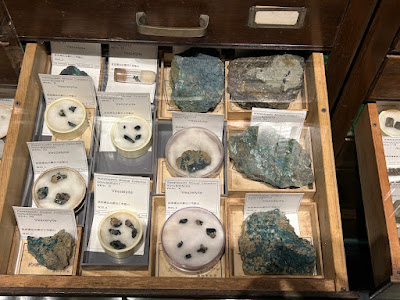東京大学・若林鉱物標本 Wakabayashi Mineral Collection, University of Tokyo
東京大学総合研究博物館にて「東京大学・若林鉱物標本 日本の鉱山黄金時代の投影」と題する特別展示がおこなわれているので行ってきた。場所は東大本郷キャンパスの南西端で、地下鉄本郷三丁目駅から歩いてすぐのところにある。会期は2023年9月1日まで。開館日は基本的に月曜から金曜までの平日に限られている。
若林鉱物標本は、三菱鉱業(いまの三菱マテリアル)の技師でのちに会社顧問まで務めた若林弥一郎(わかばやしやいちろう、1874-1943)の「個人的な」鉱物コレクションで、彼の還暦のときに母校である東京帝国大学(いまの東京大学)に寄贈された。その数2000点あまり。その多くは基本的に非公開だったが、2022年の秋にほぼすべての標本の画像がインターネット上で公開されたことで、コレクションの全容があきらかになった。今回の展示はそのうち約900点の実物を一般の観覧に供したものである。
I visited the University Museum, University of Tokyo, to see the special exhibition: Wakabayashi Mineral Collection. This is Wakabayashi Yaichiro's personal collection, which consists of about 2000 mineral specimens and was donated to his alma mater at the age of sixty around 90 years ago. In the fall of 2022, photos of all the specimens were uploaded on the internet, and about 900 specimens are chosen to be displayed at this exhibition. The location is close to the Hongo 3-chome station. The museum is open Monday through Friday, and the exhibition is on display until September 1st, 2023.
A calcite twin from the Furokura Mine, Kazuno City, Akita, Japan.
明治7年(1874年)に金沢で生まれた若林弥一郎は、大学卒業後の明治31年(1898年)に三菱に入社し、技師として秋田県の荒川鉱山に配属された。ちょうど三菱が荒川鉱山を買収して2年後にあたり、鉱山設備を近代化して新たな生産計画を実行していた頃である。若林の秋田勤めは約15年にも及んだ。よってコレクションには荒川鉱山をはじめとする秋田県産の石が多く、全体の約3割を占める。鉱山技師という職業柄か、彼の興味も金属鉱石たる硫化鉱物や脈石として産する酸化鉱物、炭酸塩・硫酸塩鉱物の類に傾いたようで、鉱物界の中で最も種類が多い珪酸塩鉱物のコレクションはむしろ少なく感じられる。
キャリア組(?)として順調に出世して明治42年(1909年)には荒川鉱山長となり、その後も三菱本社の要職を歴任した。大正12年(1923年)、工学博士を取得。晩年は「日本鉱物誌 3版」の編纂に参画し、またのちに著名な鉱物コレクターとして知られることになる桜井欽一少年を見出し、当時の東京帝大鉱物学教室の伊藤貞市に引き合わせて研鑽の便宜を図るなど、学界のみならず鉱物趣味界に多大な影響を及ぼした。昭和18年(1943年)、69歳で亡くなった。
若林の専門はどちらかというと工学寄りの鉱山学(とくに探鉱法)で、鉱物学の専門家というわけではなかった。おそらく職業上の理由以上に、もっと純粋な科学的興味にかきたてられた、生粋の鉱物愛好家だったのだろう。たとえば明治33年(1900年)に若林が荒川の支山である日三市(ひさいち)鉱山で発見した青色透明なリン酸塩鉱物は、当初新鉱物と目せられて「荒川石」の名まで与えられ、若林自身もいくつかの論文を書いている。最終的にはこれは既存鉱物種のベゼリ石(veszelyite: Cu2Zn(PO4)(OH)3·2H2O)であると結論づけられたが、展示品にもある大量のベゼリ石にはある種のコレクター魂のようなものを感じる。他にも荒川鉱山では三角式黄銅鉱やぬけがら水晶(重晶石後の石英仮晶)などのちょっと奇妙な鉱物標本を大量にあつめており、なにか自然が織りなす神秘的な造形に魅了されたようすがうかがい知れる。
Wakabayashi Yaichiro was born in Kanazawa in 1874, and entered Mitsubishi Company shortly after graduating in 1898. He spent nearly 15 years at the Arakawa Mine, Akita, as a mining engineer. That is why about 30% of his mineral specimens came from Akita prefecture, mainly composed of sulfides as metal ores and oxides, carbonates and sulfates as gangue. He became the chief of the mine in 1909, and took several responsible posts in Mitsubishi Company in his latter career. Wakabayashi had an influence on Japanese mineralogical and mineral-collector societies. For example, he was a member of editing committee for the third edition of "Minerals of Japan". It was because of Wakabayashi's intercession that Sakurai Kin'ichi, known as a famous mineral collector later, could meet Prof. Ito Teiichi, University of Tokyo, and study mineralogy there in spite of his young age. Wakabayashi passed away in 1943 at the age of 69.
Wakabayashi was a mining engineer rather than a mineralogist. I think he was a genuine mineral collector motivated by pure scientific interest in nature. In 1900, he found a blue transparent phosphate mineral at the Hisaichi Mine, Akita, which was first thought as a new mineral species, Arakawaite, and he wrote papers about it. This mineral turned out to be veszelyite later, but it seems to me that numerous veszelyite specimens displayed at the museum indicate a collector's spirit. Wakabayashi also collected numerous chalcopyrite that had triangular or acicular crystal habits and quartz pseudomorph after barite at the Arakawa Mine. These peculiar crystals are displayed at this exhibition too.
A shelf containing many veszelyite crystals that Wakabayashi collected at the Hisaichi Mine.
Quartz pseudomorph from the Arakawa Mine. Barite that once crystalized disappeared and quartz covering that remained. It is like a sword sheathe.
There is a room with a glass floor, and we can see many small mineral specimens stored underneath. A golden crystal at the center is Arakawa's triangular chalcopyrite with a base size of 4 to 5 cm.
晩年の若林を知る桜井欽一によれば、彼は「気むづかし屋の雷親爺という反面、思い切って飄逸、洒脱なところ」があったらしい。ある標本店の新着セールで桜井が先に入店して鉱物を物色したところ「俺より先に行ってよいのを抜いてくるとは不届千万だ」とあとから怒られたという。その一方で桜井がお願いすれば「貴重な標本でもドンドンわけて下さる」というような「親分肌」な面があった。また鉱山監督官だった新井琴次郎が荒川鉱山の案内を若林に請うたとき、坑内のどこにも若林の姿がなく不審におもったところ、当の本人は昼飯で一杯やったらしく傍らの木材の上で寝ていた、といった逸話は若林の豪快な性格を物語っている。
Sakurai described that Wakabayashi was a stubborn old man but had a free-and-easy mind. On the one hand, Wakabayashi got angry when Sakurai rushed into a sale and made a purchase at a mineral shop, saying that it was quite rude of Sakurai to buy good things before him. On the other hand, Wakabayashi gave precious pieces without hesitation if Sakurai requested. When Arai Kotojiro was at a mining inspection office, he went to the Arakawa Mine and asked Wakabayashi to guide the mine. However, Arai was confused because Wakabayashi didn't appear. Arai finally found Wakabayashi napping outside after drinking at lunch. These episodes indicate Wakabayashi's bold personality.
補足
若林の経歴やコレクションの成り立ち等については東京大学総合研究博物館データベースのページを参照した。コレクションの約3割が秋田県産、と書いたが、これはここに載っている標本リストを見てわたしが勘定したものである。またコレクションの詳細は以下でも述べられている:
若林のエピソードについては:
荒川石(ベゼリ石)については:
- 若林弥一郎・駒田亥久雄「秋田県三菱日三市鉱山の燐酸亜鉛銅鉱物」(地質学雑誌、28巻 332号、191〜211ページ、1921年)
- 「本邦鉱物図誌4」の「荒川石」の項目(伊藤貞市 編、大地書院、561〜563ページ、1941年)
石英仮晶については:
展示スペースが狭いこともあり、約900点と標榜する標本の多くはガラス張りの床下に陳列されている。よくよく見るとすごく貴重な標本ばかりで、ガラスが割れて踏んづけてしまいそうな気がして躊躇する。AGC製の強化ガラスは滑り止めのため表面に「ボコボコ」がついているので大変見にくい。あと青色が強いLED照明で標本をライトアップしているコーナーがあって、鉱物本来の色が見えにくい。せっかくの苗木のブルートパーズが、照明のせいでブルーなのかなんなのかわからなくなっている(ただし北海道手稲鉱山の硫砒銅鉱は端面がオレンジ色っぽく光ってむしろ青色の光で正解だろう)。ベゼリ石についてもあんな薄暗い棚でなく、どれか選りすぐりの1個でいいからもっと宝石みたいにライトアップして陳列してほしい。総じて、権威ある自分たちが所有する標本は下々の者にはチラ見せしておきゃあいい、みたいな出し惜しみ感が充満して悪趣味である。無料で見せてもらっているので文句は言えないが。。。
下の図はこの報文中に掲載されている模式図(若林の直筆?)。あつめた標本をもとにいくつかのタイプに分類している。
追記
東京大学総合研究博物館ニュースに掲載の本展示に関する記事(三河内岳、ウロボロス 2023年27巻3号、2〜4ページ)によると、若林標本はずいぶん長い間劣悪環境に置かれており、今回の展示でようやく「救出」されたのらしい。ここに至るまでには相当の時間と労力を費やしたそうで、敬意を表する。というか、貴重なはずの寄贈標本を数十年もほったらかし(?)にしてきた過去の東大教官のお歴々の怠慢を批判すべきなのかもしれないが、きっとこういう標本の保存・整理作業は研究業績として評価されないから、だれもやりたがらない仕事だったのだろう。
石英仮晶の表面の黄銅鉱は変質して黒くなっているが、これは長期間劣悪環境に置かれたおかげで変質してしまったわけではなく、明治期に採集されたときからこの色だったと思われる。三角式もしくは針状の黄銅鉱も黒いものが多いが、これも同様と考えられる。このことは若林の地質学雑誌の報文(1903年)に「普通その(=荒川鉱山の黄銅鉱の)表面は黒色に酸化す」とあることからも伺える。他にも荒川の黄銅鉱に関しては
「品位良等なるものはしばしば斑銅鉱の光沢を呈せり」(三浦宗次郎、地学雑誌、5巻 5号、1893年)
「これらの(=測角した三角式の)黄銅鉱には著しき tarnish colour を示すもの多く・・・」「(1 -1 1) は多くの場合ほとんどまったく tarnish colour を示すことなく、(1 1 1) はやや tarnish colour を示す」(渡邊新六、岩石鉱物鉱床学誌、10巻 1号、1933年)
などの記載がある。渡邊の記事は採集後30年以上経た標本に関するものなので、その間に変質した可能性もないではない。がともかく、荒川鉱山の黄銅鉱脈は固化後に二次的酸化作用(おそらく深部からの熱水の侵入)を広範囲にわたってこうむった形跡があり、これと三角式黄銅鉱の晶出、および重晶石後の石英仮晶の生成とは無関係ではないだろう。(以上、2023年5月13日)




